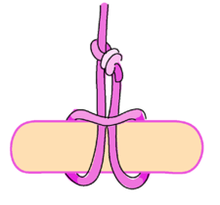Cow hitch
| Cow hitch | |
|---|---|
 | |
| Names | Cow hitch, Lark's head, Lark's foot, Girth hitch, Ring hitch, Lanyard hitch, Bale Sling hitch, Baggage Tag Loop, Tag Knot, Deadeye hitch, Running eye |
| Category | Hitch |
| Origin | Ancient |
| Related | Clove hitch, Cat's paw, Bale sling hitch, Prusik, Halter hitch |
| Releasing | Non-jamming |
| Typical use | Tying a rope to a ring or pole |
| Caveat | Can fail unless equal tension is applied to both of the standing parts of the rope. |
| ABoK | #5, #56, #59, #244, #1184, #1673, #1694, #1698, #1700, #1802, #2163, #2164, #2168, #2175, #3317 |
The cow hitch is a hitch knot used to attach a rope to an object. The cow hitch comprises a pair of half-hitches tied in opposing directions, as compared to the clove hitch in which the half-hitches are tied in the same direction. It has several variations and is known under a variety of names. It can be tied either with the end of the rope or with a bight.
History
A simple and useful knotted structure, the cow hitch has been known since at least the first century when described by Greek physician Heraklas in a monograph on surgical knots and slings.[1] Known under a variety of names, this knot has been used both on land and at sea.[2] The common alternate name lark's head is attributed to Tom Bowling (pseudonym) in the 1866 work The Book of Knots which is presumed to have been adapted from a French manuscript; lark's head is a literal translation of the French name for the knot, tête d'alouette.[3]
Variations
The underlying cow hitch structure can be formed and used in a variety of ways. These variations are differentiated by method used to form the knot and the way in which it is loaded.[4] In particular, the knot can be formed with an end of the rope, in a closed loop or strap, or a combination of these two in which it is tied with the end and then formed into a loop by securing the free end to the standing part. Although certain names tend to be historically associated with a particular variations, real-world naming is not necessarily consistent between various users and applications.
With the end
When tied using the end of a rope, such as when securing an animal's lead to a vertical post or stake, this knot was said to be more resistant to loosening than the clove hitch as the animal wanders around the post.[5] In general, however, this single-ended form of the cow hitch is less stable compared to the variations in which both ends are loaded.[6][7]
In a closed loop or strap
This form is commonly known as a strap hitch or girth hitch. The latter term being common among climbers. It is the method commonly used to attach luggage tags which have a pre-tied loop of string or elastic. This form is also often used to connect loop-ended lanyards to handheld electronic equipment, since it can be tied without access to the ends of the fastening loop.
With the end, then secured into a loop
When tied by threading the end and then the end is secured to the standing part, the knot is known as a bale sling hitch.
 Made with a closed loop
Made with a closed loop Shown being used to hoist a barrel, and (left) for tying a lead to a sounding line
Shown being used to hoist a barrel, and (left) for tying a lead to a sounding line Made with an eye splice around a ring
Made with an eye splice around a ring Made with end and then secured to standing part
Made with end and then secured to standing part
Applications
Tatting
The craft of tatting is composed primarily of lark's head knots over carrier threads. A lark's head is called a double stitch in tatting.
Friendship bracelets
In the context of friendship bracelets, the lark's head is called the reverse knot or the forward backward knot or the backward forward knot if the author is being directionally specific for instructional purposes.
Cableman's hitch
Another application for the cow hitch is in the handling of large electric power cable in surface mines. Known colloquially as a "Cableman's hitch", it is also used to attach loops of cable to the back of a pick-up truck during a shovel move. As the cable can weigh upwards of 22 pounds per foot and 3–4 loops of cable can be attached to one length of rope, a clove hitch's shearing force would damage the cable jacket. The Cableman's hitch puts the strain onto the hitch crossing over the two running ends of the rope.
Products that use cow hitch knots
- The Nintendo Wiimote, for securing the strap to the Wiimote
- Some Mobile phones accessory use this knot to secure themselves to the phones
- Textile/Rubber Bands attached to the Zip Pullers is usually tied with Cow Hitch, usually to reduce the size of the Puller.
See also
References
- ↑ Hage, J. Joris (April 2008), "Heraklas on Knots: Sixteen Surgical Nooses and Knots from the First Century A.D.", World Journal of Surgery, 32 (4), p. 650, PMID 18224483, doi:10.1007/s00268-007-9359-x, retrieved 2009-07-15
- ↑ Ashley, Clifford W. (1944), The Ashley Book of Knots, New York: Doubleday, p. 305
- ↑ Ahsley, p. 11.
- ↑ Ashley, p. 290.
- ↑ Ashley, p. 44.
- ↑ Cyrus Lawrence Day (1986), The Art of Knotting and Splicing (4th ed.), Annapolis: Naval Institute Press, pp. 94–95
- ↑ Soles, Clyde (2004). The Outdoor Knot Book. Seattle: The Mountaineers Books. pp. 96–97. ISBN 978-0-89886-962-0.